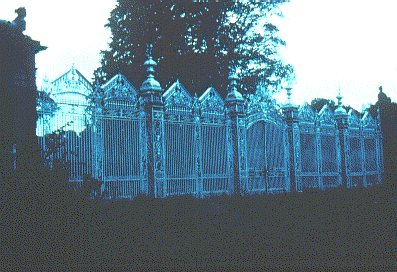
ESDEP WG 1B
STEEL CONSTRUCTION:
INTRODUCTION TO DESIGN
To review developments in steel building construction, demonstrating how improvements in material and understanding have enabled greater achievements in terms of height, clear spans and building efficiency.
None.
Lecture 1B.4.1: Historical Development of Iron and Steel in Structures
Lecture 1B.4.2: Historical Development of Steelwork Design
Lecture 1B.4.4: Historical Development of Iron and Steel in Bridges
Iron was originally used for the principal components in building structures in order to achieve fire resistant construction. Initial forms followed traditional patterns, but gradually the characteristics of iron, and subsequently steel, were more fully utilised. Various building categories are considered - mill buildings, long span roofs, and multi-storey buildings. Significant technical innovations and design approaches are highlighted.
Although the history of iron and steel dates back several hundred years, their use in the main components of building structures is relatively recent. The Industrial Revolution provided both the means and the need. Coke smelting and steam power enabled greatly increased production of iron, and the industrial mill buildings were foremost in the structural use of the material to replace timber. Inevitably, the adoption of a new material is spasmodic, and at times may even become unfashionable. Wrought iron, for instance, never totally replaced cast iron, any more than cast iron replaced timber. Any historical review will, therefore, include discontinuities rather than be a smooth sequential development. To simplify this review, the history is, therefore, subdivided by building type - mills and industrial buildings, long span roofs such as conservatories, railway stations and exhibition halls, and multi-storey frames. The development of new design forms to take advantage of improvements in material characteristics is traced for each type.
Steel and before that iron, have been used in building construction for a very long time. The first uses were as secondary components - connectors, shoes and straps, mainly in combination with timber as the principal structural material. As early as the 6th Century, iron tie bars were incorporated in the main arcades of the Haghia Sophia in Istanbul. Domes often relied on tie bars to reinforce their base, such as in Jacques Germain Soufflot's portico of the Pantheon in Paris (1770-72). However, the most prominent early application of the material was in the decorative use of wrought iron, for instance, in balustrades and gates. An outstanding example is to be found in the White Gates at Leeswood in Clwyd, Wales (1726) (Slide 8). Thomas Rickman combined the structural utility of cast iron columns with delicate ornament in the gallery fronts and ceilings to the nave and aisles of St George's Church, Everton, UK (1812-14) (Slide 9). In France, the architect Henri Labrouste designed two notable libraries. The Bibliotheque Sainte Geneviève (1843-50) (Slide 10) utilises cast iron for columns and arches to support both roof and floor, whilst at the Bibliotheque Nationale (1858-68) (Slide 11), the same decorative use is made of cast iron, but this time in combination with wrought iron.

Slide 8
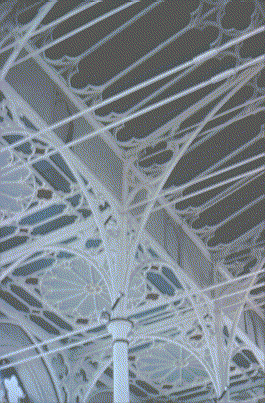
Slide 9
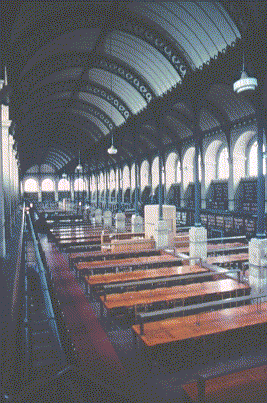
Slide 10
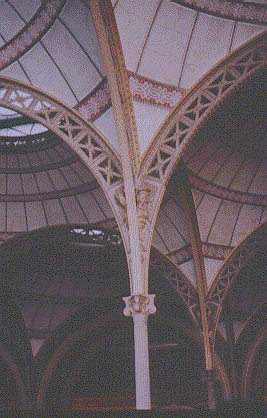
Slide 11
These and some other early examples of public buildings which used iron exposed the structure in the interior but gave no sign of it from outside. J.B. Bunning's Coal Exchange in the City of London (1849) incorporated an iron framed galleried atrium behind two palazzo office blocks, while the Bibliotheque Sainte Geneviève had a scholarly Renaissance stone facade. Dean and Woodward used iron and glass extensively for their Oxford Museum (1860) (Slide 12) creating a dramatic interior.

Slide 12
The introduction of iron components as principal structural elements is a relatively recent development, inspired by the desire for fire resistant construction. Earlier timber framed construction was always vulnerable to fire, particularly in textile mills where cotton fibres were processed in an oily, candle-lit atmosphere. By the end of the 18th Century iron was beginning to replace timber for the main structure. Initially, this was for the columns only, the first examples being a cotton mill in Derby, UK and a warehouse in Milford, UK (1792-93). The designer William Strutt used brick jack arches in place of the traditional timber floor. The jack arches sprang from iron plated timber beams with a plastered soffit to provide increased fire resistance. The beams were supported externally on the masonry walls and internally on cast iron columns.
The next logical progression was to use iron instead of timber for the beams. The first example of such a building frame was Charles Bage's Flax Mill at Shrewsbury, built in 1796 (Slide 13). The external masonry is loadbearing, but internally slender cast iron columns support cast iron lattice girders enclosed within brick arch floors. The building still stands today, having been used most recently as a maltings. The beams were cast in two sections, bolted together, with a skewback base, designed to carry brick arches. Their profile, which was concealed by the brickwork, rises at mid-span.
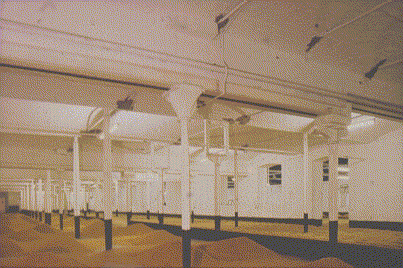
Slide 13
The combination of an external loadbearing masonry envelope and an internal iron frame became a common form in Britain, particularly for industrial buildings, such as the Albert Dock buildings in Liverpool (Slide 14). These buildings were constructed in 1845 and have recently been refurbished to provide office and residential accommodation. This period of structural design using iron was characterised more by evolution of form than by revolutionary new systems. Beam cross-sections saw the development of first the inverted T section (the bottom flange carrying the arch) and later the I section. Column sections also altered. Cruciform sections were superseded by circular hollow sections which could also accommodate steam heating or rainwater flow.
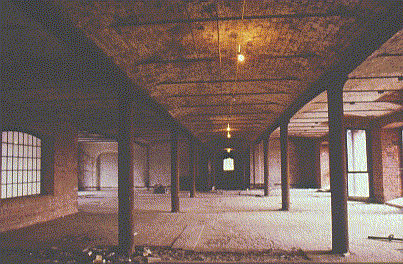
Slide 14
In 1856, Gardener's store (Slide 15) - an elegant furniture warehouse - was erected in Jamaica Street, Glasgow. This building used a cast iron frame system patented by a local ironfounder, Robert McConnel, for the facade, but the flooring system was based on a timber structure. The framing system allowed a rich expression of the fenestration, and was similar in principle to those first used in St Louis, USA.
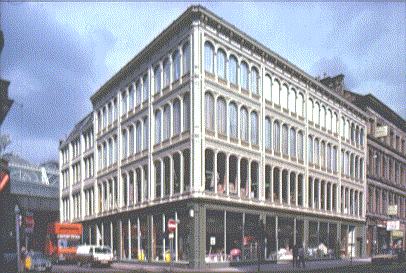
Slide 15
The first building with a true rigid iron frame, making no structural use of loadbearing masonry, was Greene's Boat House completed in 1858 (Slide 16) at the naval dockyard, Sheerness, UK. This building was a four storey, three bay frame 64m by 41m by 16m high. The primary beams are of riveted wrought iron and span 9m. The secondary beams are cast iron and span 4m. Corner columns are hollow cast iron and are used as down pipes, whilst others are of H-section. The frame not only carried the full vertical loads but also provided the lateral stability.
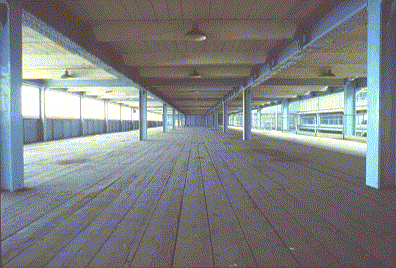
Slide 16
In France, the first fully framed building was the Menier Chocolate Factory (Slide 17) at Noisiel-sur-Marne, completed in 1872. The most distinctive feature of this building, which is constructed over the River Marne which powered its machinery, is the diagonal bracing which is so elegantly (Slide 18) expressed on the exterior. This bracing provides the necessary lateral rigidity to the slender wrought iron skeleton, the decorative brick infill walls serving no structural purpose.
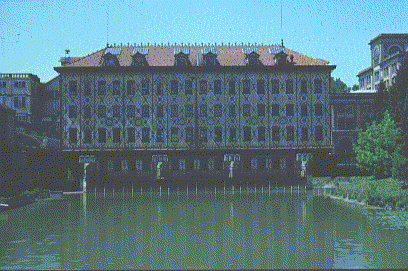
Slide 17
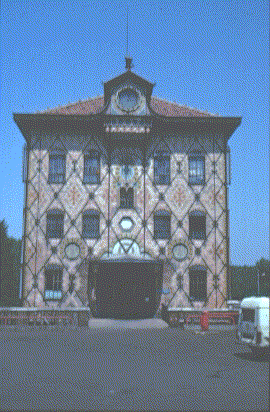
Slide 18
In Germany, an octagonal steel frame was used by Bruno Taut to support a gold coloured sphere in his design for the pavilion at the Leipzig Fair (1913) and Peter Behrens designed a steel three pin arch for the AEG turbine hall in Berlin (1909) (Slide 19).
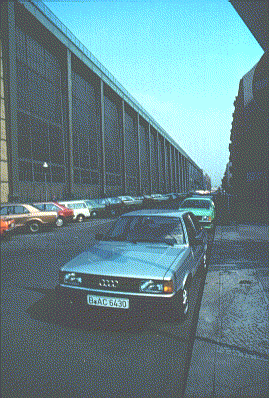
Slide 19
The introduction of bracing systems freed the structure from its dependence on masonry walls for stability, and other materials began to be employed. Corrugated iron, the ancestor of today's profiled steel sheet (Slide 20) was patented in 1829. Forming iron into thin sheets with undulations to give stiffness was the idea of Henry Robinson Palmer who worked for the London Dock and Harbour Company. The corrugated sheets were manufactured by Richard Walker and were used on warehouse and storage buildings at the docks.

Slide 20
The combination of steel frame and lightweight cladding has continued to be a popular solution for industrial buildings. Many of the structural forms have been developed to create longer roof spans, and here the historical development merges with that of other building types.
The developments in iron bridge construction were paralleled by those in long span roof forms. In 1786, Victor Louis designed a tied arch roof using wrought iron to span 21m over the Theatre Francais. He introduced many sophisticated features such as shaping fabricated elements to provide greatest resistance to bending and buckling and achieving a form which was both elegant and daring: qualities which characterised French iron structures for more than a Century afterwards.
Many of the early clear span iron structures borrowed ideas and principles from contemporary masonry and timber construction, such as the stone arch on which many cast iron bridges were based. Often timber structures destroyed by fire were replaced by iron structures of a similar form. Examples include the cupola of the Granary in Paris (destroyed by fire in 1802 and replaced in 1811) and the roof of Chartres Cathedral (1836) (Slide 21). Here cast iron was used by Emile Martin for the curved frames of the arching roof, but the tie rods at the springing were wrought iron. The roof spans 14,2m with a clear height of more than 10m from vaulting to apex.
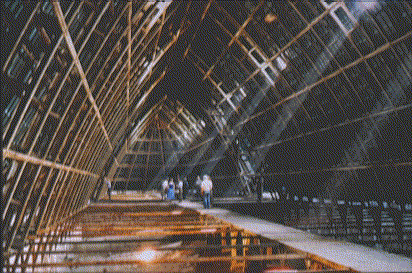
Slide 21
In the first half of the nineteenth Century many innovative iron structures were built in France where technical, educational and scientific understanding were most advanced. Wrought iron was used for other long span roof structures in France, such as La Bourse (1823) (Slide 22). It is interesting to note that in Britain cast iron remained the favoured material for buildings constructed during the same period - for instance, the floors of Buckingham Palace and the floors and roof of the British Museum.
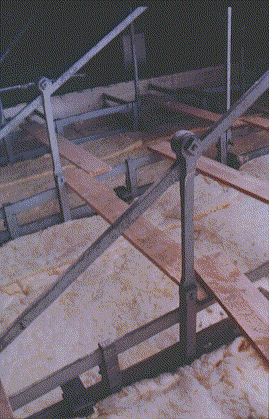
Slide 22
In both Britain and France, iron and glass were married in the construction of numerous glasshouses and conservatories, the slender glazing bars making iron an ideal material. Early examples include a palm house at Bicton, Devon (1816) (Slide 23) which uses a wrought iron glazing bar system devised by Loudon. This system established a pattern for glasshouse construction, and a later example is Turner and Burton's Palm House at Kew (c. 1847) (Slide 24) which uses curved ironwork throughout. Both of these examples have recently been restored. The latter is 110m long with a maximum clear span of 15,2m and raised to 19m at its centre. The structure of the main ribs is of curved wrought iron beams, as used in the construction of ships decks. The purlins, also of wrought iron, consist of a tensioned rod running within a pipe between ribs. The decision to substitute wrought iron for cast iron substantially reduced the weight of the structure and allowed greater light penetration into the building - a very important consideration in glasshouse construction.

Slide 23
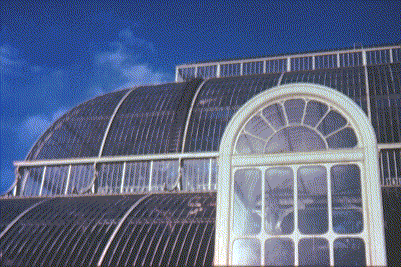
Slide 24
Similar forms were used to build very long span roofs over railway termini. The roof at Euston station (1835-39) consisting of two 13m spans supported on slender cast iron columns, is believed to be the first example of all iron roof truss construction. The designer, Charles Fox, working under Robert Stephenson, used rolled iron T sections for the rafters and the compression members and rolled bar for the tension members. The connections were made by forging and drilling ends to the bars for bolting, with wedges used for adjustment. However, an accident at this station in which a derailed train demolished an internal column causing a partial roof collapse, led to the need for clear spans. Notable examples include Turner's Liverpool Lime Street, spanning 47m (1849) and Barlow's St.Pancras spanning 73m (1868) (Slide 25).
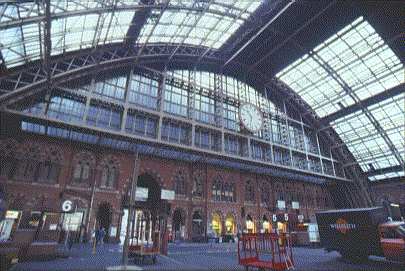
Slide 25
At Liverpool Lime Street the structure took the form of arched trusses, sliding joints at the supports preventing lateral thrusts being transferred to the supports and thus avoiding arching action. The construction of the roof was completed in 10 months. In contrast, St. Pancras uses a trussed arch with the outward thrusts at the springing contained by ties located below platform level. It is interesting to note that many of the designs for these long span roof structures were regarded as so innovative that the railway companies demanded full scale tests to demonstrate their integrity.
In France, Camille Polonceau developed a simple trussed rafter system using iron, sometimes in combination with timber. This system was widely used in a variety of building types, including the roofs over the Paris-Versailles Railway (1837). These trusses had timber principals, cast iron struts and wrought iron ties.
Paxton's Crystal Palace (1851) (Slide 26) was another remarkable structure built during this period. His design for the exhibition hall was a rectangular building 564m long by 22m wide and rising to a maximum height of 32m. It consisted of a framework of cast iron columns with cast and wrought iron trusses, connected using wrought iron and wood keys. However, much of the credit for this structure must go to the ironwork contractors Fox Henderson & Co. They were responsible for the structural analysis, working drawings and construction, bringing their experience on bridges, dockyard roofs and prefabricated buildings to enable completion of the building within a period of four months. Other major buildings by them include the trainsheds at Paddington (1851-4) and Birmingham New Street (1854).
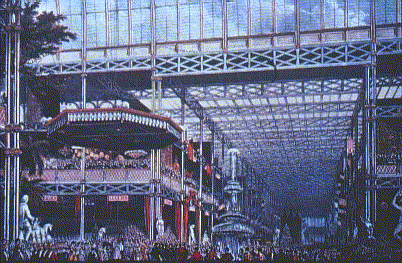
Slide 26
In France, one of the most spectacular exhibition halls, the Galerie des Machines (Slide 27) was built for the 1889 Paris exhibition. It was the architect Dutert whose idea it was to enclose the 420m long, 110m wide hall with a single span. In conjunction with engineers Contamin, Pierron and Charton he developed the three-pinned, trussed steel portal frame, rising at its apex to a height of 43m. Like the Eiffel Tower (Slide 28), it was constructed from many small sections and plates riveted together in truss-like form. The purlins, too, were of lattice construction. The scale of the detail was enormous.
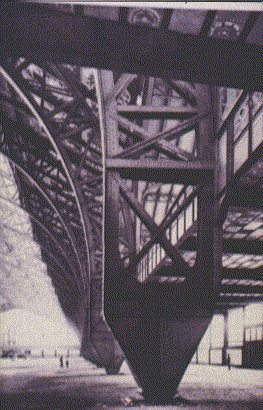
Slide 27
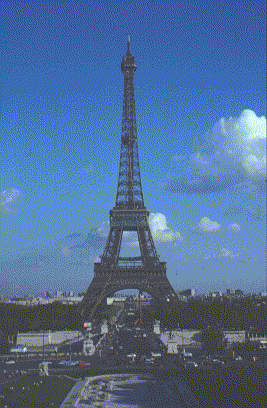
Slide 28
In America, too, the iron truss gradually gained favour, an early example being the Library of Congress in the Capitol Building, Washington (1854). However, it was the emergence of the mass production industries in the 1920s and their highly developed factory layouts which provided the opportunities for new structural forms, pioneered by Albert Kahn. The need for production flexibility dictated wide span industrial buildings. Deep lattice truss construction had been used for some time in bridge design and Kahn adopted this for many of his buildings. Natural lighting was provided in the production areas by adopting a monitor roof form. This improved lighting compared with north light roof forms, but avoided excessive heat gain.
Examples of this form of construction include the press shop for Chrysler at Detroit (1936) and the Assembly Building for the Glenn Martin Aircraft Company at Baltimore (1937). Trusses 9m deep spanned over 90m to give a column-free floor area of 150m by 100m. The monitor roof light was achieved by bridging alternately between the top and bottom chords of these trusses.
As spans became longer, so lateral stability of the trusses became more critical. This was countered by using box or triangular cross-section trusses. The trend towards longer spans led to the development of space frame construction which allowed advantage to be taken of the ability of such structures to span in two directions. In fact, the development of this has its origins in the work of Alexander Graham Bell at the beginning of the 20th Century. However, the first system widely available commercially, the MERO system, was not introduced until the 1940s. This structural form has proved a popular method for roofing long spans very efficiently, and other commercial systems have developed and continue to be used up to the present.
Just as iron was becoming more popular as a structural material for mill buildings and long span roofs, so too was it being increasingly used for multi-storey building construction. It was in North America and, in particular, Chicago that most development took place. Two important influences were the need to build higher to overcome the chronic overcrowding of cities of the period, and the terrible fire of 1871 which completely devastated the commercial quarter of Chicago. Another vital element in the development of high-rise construction was the introduction of the passenger lift by Elisha Otis in 1853.
Just as with industrial building development, changes in the form of construction took place in several steps. By the 1860s cast iron columns and wrought iron girders were commonly used to support brick arch floors, but with external loadbearing masonry still carrying a proportion of the vertical loads and providing lateral stability. William le Baron Jenney's First Leiter building (Slide 29), completed in 1879 in Chicago, for instance, is basically a hybrid with timber secondary beams, wrought iron primary beams, cast iron columns (internal) and masonry piers on the perimeter.
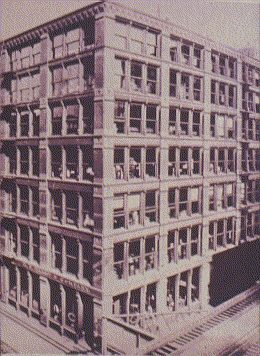
Slide 29
Before their general use for commercial buildings, tall iron frame structures began to appear towards the end of the 19th Century. Perhaps the most famous of these is the Eiffel Tower which remains as one of the most potent symbols of iron construction. Built as a temporary monument to crown the 1889 Paris Exposition, at 300m it was the highest structure of its time (although other similar towers had been proposed in cast iron as early as 1833). The design of the tower was, in fact, developed initially by Koechlin and Nougier, two engineers working in Eiffel's office. An architect, Sauvestre, also working for Eiffel, made important modifications including joining the first level and the four main legs with monumental arches. Eiffel, however, assumed responsibility for its construction.
Other notable structures of this type include the Latting Observatory Tower (1853) and Statue of Liberty (1886), both in New York.
It was not until about 1880 in the USA that the full potential of iron and steel frames was realised and they became standard for high buildings. The advantages of a frame structure can be seen by comparing the loadbearing masonry Monadnock Building, Chicago (1885) with the second Monadnock Building completed in 1891 using a steel frame. The walls of the earlier building measure 4,5m thick at their base. However, as late as 1890 loadbearing masonry was used for the Pullitzer Building, New York with walls 2,7m thick.
It was recognised that substituting iron or steel for timber was not the complete answer to providing fire safety since unprotected iron beams would lose their strength at high temperatures and cast iron columns could fail when suddenly cooled by water from fire hoses. Some form of additional fire protection was, therefore, necessary. This requirement was clearly demonstrated by a plaster encased building structure which survived the Chicago fire.
The jack arch floor construction methods used earlier for mill buildings were largely unsuitable for resisting fire, partly because of their weight and partly because the lower flange of the iron beam would be exposed in the event of a fire. Terracotta flooring, in which hollow blocks of terracotta formed 'flat arches' to span between the lower flanges of the beams, overcame both of these problems. An early example of this form of floor construction is the 7-storey Tribune Building in New York (1869) which was also one of the first buildings to incorporate a passenger lift. Various systems based on this principle were developed. The blocks were arranged to project below the lower flange of the beam which was afforded fire protection either by projecting flanges of terracotta, or by cover slips of terracotta supported on small nibs. Floor finishes were either terracotta floor tiles or concrete, and their weight was about half that of the brick and concrete arch floors. This meant a significant reduction in the self weight of the structure and hence the load to be carried by the walls, columns and foundations, which was particularly important in Chicago with its poor subsoil conditions.
Other floor systems were developed using expanded metal as permanent shuttering but these needed separate ceilings. In 1846 the first iron beam was rolled in France, with the subsequent development of floor systems such as Système Vaux and Système Thuasne. These consisted of wrought iron beams at about 600-900mm centres connected by iron rods with a thick (70mm) plaster ceiling encasing the lower part of the beam. In Britain 'filler joist' floors, comprising closely spaced joists with concrete cast between, became common during the early part of the 20th Century. In many respects these floors can be seen as the precursor to the composite and reinforced concrete floor slab systems in current use.
The iron beams supporting the floors were initially formed as truss-like girders by riveting small cast or wrought iron elements. These girders were relatively deep and the planning was generally arranged so that they could be incorporated within partition walls. It was not until much later that rolling of wide flanged beams became possible, allowing shallower construction depth and hence greater planning freedom.
Cast iron columns remained popular for some time. It was not until the recognition of the need for bending strength within columns to deal with eccentric loads, that wrought iron, and subsequently steel, really took over. Like beams, the columns were initially formed by riveting a number of small sections to form a cross-section with similar bending strengths about both axes.
The first move towards a fully framed form of construction was the introduction of columns within (or in front of) the external walls so that the masonry carried only its self weight and none of the floor loads. Only when the frame carried not only the floor loads but also the external wall was the height of construction no longer limited by the ability of the wall to carry its own weight. This arrangement also solved the problem of the differential thermal expansion of masonry and iron.
Jenney's 10-storey Home Insurance Building, Chicago (1885) is considered to be the first fully framed building to adopt this form of construction and as such was the first skeletal skyscraper. Cast iron columns support wrought iron beams for the lower floors and Bessemer steel beams above the sixth floor. The frame was fire protected throughout by masonry and fire clay tiles. The external walls were carried on angles attached to the spandrel beams, although this detail was not revealed until the demolition of the building in 1931.
Another early example was the 11-storey Tower Building in New York designed by Bradford Lee Guilbert in 1887 for a very narrow site. Loadbearing masonry walls would have been so thick at their base that no useable space would have been left.
Although these developments led to structural framing systems designed to carry the full vertical load including the self weight of the external walls, the structure was still dependent on the walls for lateral stability. The cross bracing used in the exterior of the chocolate factory at Noisiel-sur-Marne was generally regarded as inappropriate for commercial buildings, and the stiffness of the connections utilised in the Crystal Palace to provide stability was recognised as being inadequate for the more onerous demands of high-rise buildings.
The first Monadnock Building, although of loadbearing masonry construction, used a combination of portal frame bracing and masonry cross walls. Many other buildings used a mixture of methods.
Jenney's 16-storey Manhattan Building, Chicago (1890) was the first with a wind braced frame. This frame consisted of a combination of portal bracing and diagonal wrought iron rods tightened with turnbuckles. This building also provides an interesting commentary on the relative material costs at the time. Steel was used only for the major beams because of its high cost, with wrought iron for secondary beams and cast iron for columns.
Burnham and Root's 22-storey Masonic Temple (1892) was braced with diagonal wrought iron rods placed in the transverse walls, whilst the Colony Building (1894) used portal frames to provide stability.
The freedom from dependence on the external masonry to provide lateral stability created new opportunities for the treatment of the facade and architects used a variety of approaches. Ground floors were often given a light form to accommodate stores, whilst the office floors above had a traditional, heavy form. The Guaranty Building (1895) and the Stock Exchange Building (1894) both by Adler and Sullivan, and the Gage group of buildings (1896/8) by Holabird and Roche (Slide 30) are typical of this approach. One of the most simple yet successful expressions of the structural frame at the time is to be seen in the Carson Pirie Scott store by Sullivan (1904) (Slide 31). More adventurous forms, however, were possible and the bay window, supported by frames cantilevered from the spandrel girders, became a common feature, providing a means of getting light into the upper floors. This feature is perhaps best seen in the Reliance Building of 1894 (Slide 32) which used terracotta cladding over the frame to give a lightness to the form. Designed by Burnham and Root it is a notable example of the slender, glazed skeletal building. The steel frame above the first floor was erected in little more than two weeks and the external envelope was completed within six months.
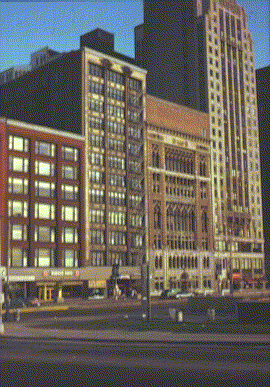
Slide 30
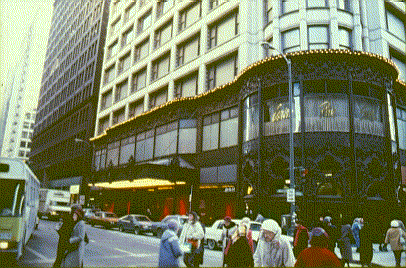
Slide 31
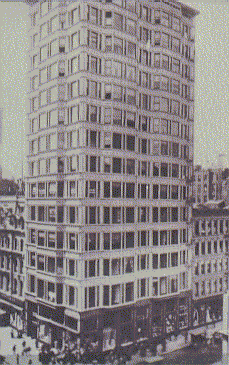
Slide 32
The greater strength of steel compared with iron enabled greater heights and longer spans to be achieved but it was relatively expensive so that it only gradually replaced wrought and cast iron, as seen in the Manhattan Building. The first all steel building was the 2nd Rand McNally Building, Chicago, built in 1889-90 and demolished in 1911.
In Europe the developments at the turn of the Century were less concerned with tall multi-storey buildings, but imaginative use was made of the potential for expressing the new structural material, particularly in France. Chedanne's office block at 124 Rue Reaumur, Paris (1904) (Slide 33) is perhaps the very first example of a true multi-storey facade in structural steelwork. In Belgium, too, Horta made extensive use of iron and steel, for instance, in the light wells he introduced in the deep sides of his buildings in Brussels, such as the Hotel Solay (1894). He also used it in both the elevations and the interior of the Maison du Peuple. Others used it in a highly decorative way, for instance the bridge, entrances, pavilions and canopies for the new railways in Paris and Vienna. A notable example is the Karlsplatz Station (1898) by Otto Wagner (Slide 34). The same designer combined glass and iron with considerable success in the Post Office Savings Bank, also in Vienna (1906) (Slide 35).
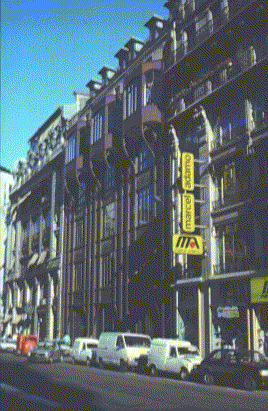
Slide 33
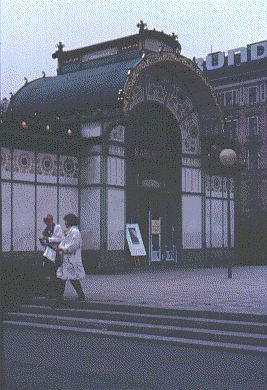
Slide 34
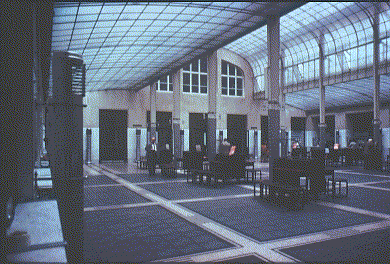
Slide 35
The first steel framed building of distinction in Britain was the Ritz Hotel, (Slide 36) London by Mewes and Davies and Sven Bylander. The main columns were of steel box section formed by connecting two channels lip-to-lip with cover plates. Foundations took the form of steel grillages encased in concrete, an unusual system outside the USA. The fire-proof floors were of a patented form comprising twin concrete slabs forming a floor over and a flat soffit below the steel beams. The large clear span over the restaurant necessitated the use of steel trusses. Fire protection to the steel was provided throughout by encasing in concrete or other incombustible material. The attraction of using steel was in speed of construction compared with traditional forms, even though building regulations in force at the time required the external walls to be 775mm thick. Thus, like many of its iron framed predecessors, the building displays nothing of its frame structure but instead has the appearance of loadbearing masonry.
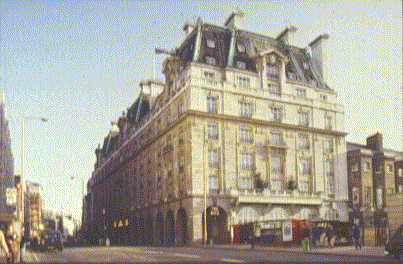
Slide 36
Subsequent relaxations in building regulations allowed thinner wall construction and designers began to express the frame structure behind, such as at Kodak House (1911) (Slide 37) by Sir John Burnet and Heal's (1916) by Smith and Brewer, with Sven Bylander as engineer.
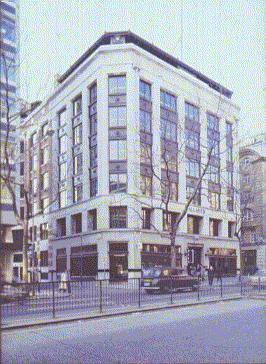
Slide 37
Building in the USA became even higher and architects used various design/stylistic approaches to break down their austerity such as the romantic medievalism typified by the 52 storey Woolworth Building (1913) (Slide 38) and both Gothic and Art Nouveau styles seen in the Chicago Tribunal Tower (1922) (Slide 39).
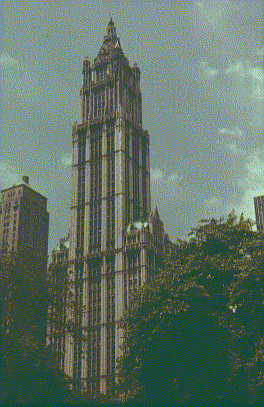
Slide 38
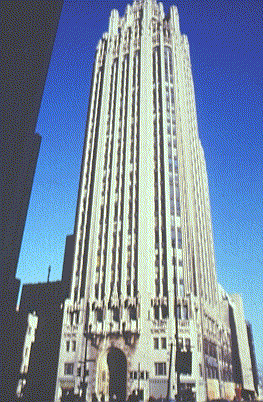
Slide 39
The following years saw the race to establish ever increasing height records with first the 320m high Chrysler building (Slide 40) with its famous stainless steel clad finial and the 380m high Empire State Building (1930) (Slide 41), which still holds the record for speed of construction, which at one stage reached one floor per day. The 70 storey RGA Radio Tower (Slide 42) which formed part of the Rockefeller Centre (1939) is notable since it represented the first development in which a skyscraper was planned as an integral part of a group of buildings rather than as a single structure.
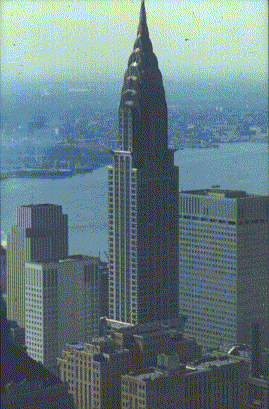
Slide 40

Slide 41

Slide 42
Meanwhile, in Europe construction heights remained modest. In 1928 the Empire Theatre, Leicester Square, London providing almost 4000 seats, was constructed. Steel framing was used to span up to 36m clear over the auditorium to support a balcony with tea rooms underneath. The floor of the balcony was supported on an arrangement of raking steel beams. Other notable buildings constructed during the 1930s include de la Warr's pavilion at Bexhill-On-Sea (Slide 43), the first all-welded steel frame in Britain, and Simpson's Department Store in Piccadilly, London (Slide 44). It was the first building to have a completely clear shop front achieved by using a Vierendeel girder across the front elevation.
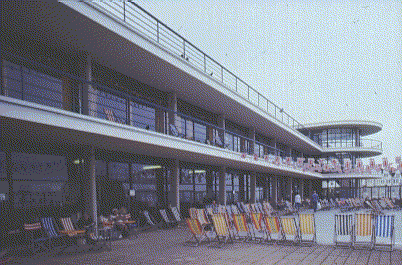
Slide 43

Slide 44
In France, Jean Prouvé pioneered many new applications and technical developments in the use of steelwork. Trained as a blacksmith, and specialising in metal furniture at his factory in Nantes, he collaborated with many leading architects on designs for cladding, many in cold formed steel. The Maison du Peuple, Clichy, Paris (1939) is one of his most famous works, utilizing pressed steel components throughout, not only for cladding, but also for windows, floors, partitions and staircases (Slide 45).

Slide 45
Following a lull in steel construction due to material shortages incurred as a result of the Second World War, architectural styles developed. Foremost amongst these was the influence of Mies van der Rohe and his use of a facade composed of prefabricated units and suspended in front of the structural frame. Early examples include the Illinois Institute of Technology (1950) (Slide 46), Lake Shore Drive apartments (1951) (Slide 47) and the Lever Building, NewYork (1953) (Slide 48). This new approach saved space and weight and speeded up construction, as well as allowing full visual expression to be given to glass and metal. One of the best known examples is the bronze coloured Seagram Building (1957) (Slide 49).
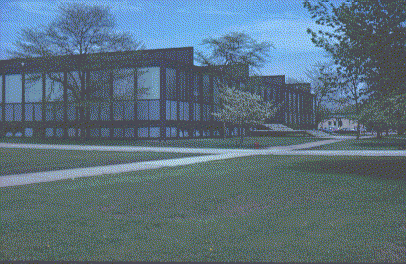
Slide 46
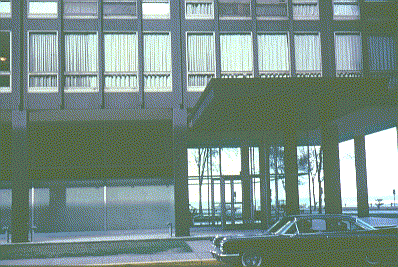
Slide 47

Slide 48

Slide 49
The evolution of form and the endeavour for increased height has continued, and these developments are chartered in Group 14.